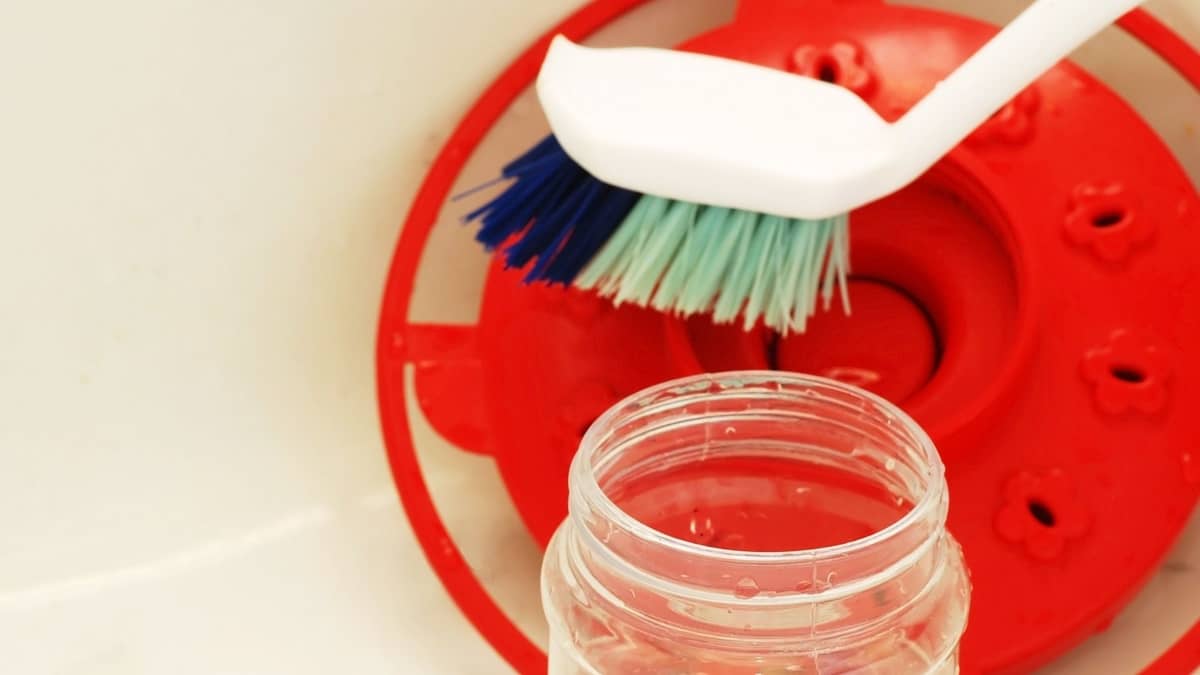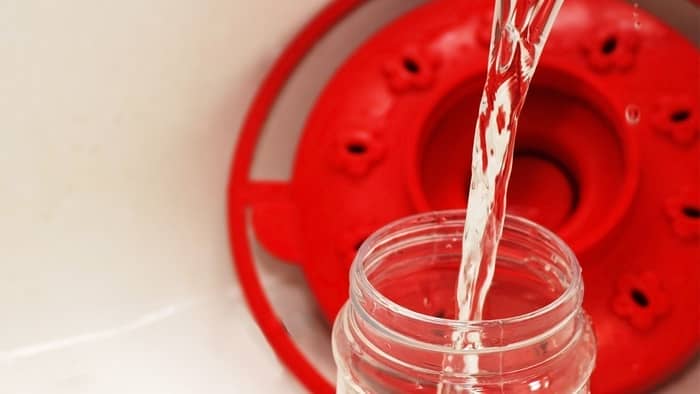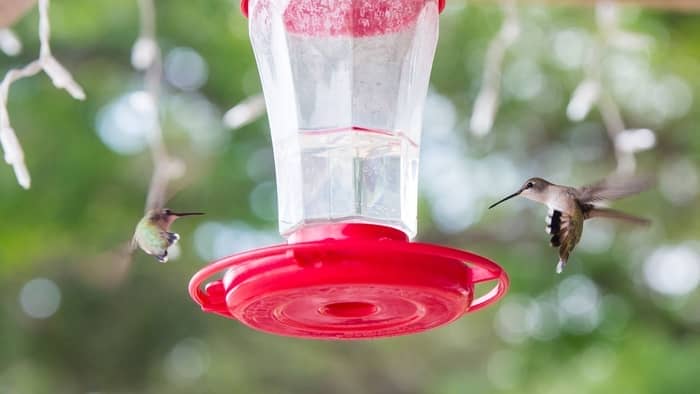Last Updated on December 31, 2021 by Guillermina
Cleaning plastic hummingbird feeders is a must, they’re filled with sticky sugar water and stay outside all the time, so they easily get trap gunk. While glass is way easier to clean, you’d have to be more gentle with plastic. It can easily break or get damaged. Also, you’re limited with the number of cleaning solutions you can use since plastic is not as resistant as glass.
So is there a way to successfully deep clean plastic hummingbird feeders? We can suggest a couple as you read on.
How Often To Clean Hummingbird Feeders
How often you need to clean your feeder depends on several factors. The season and position determine whether a more frequent cleaning is needed. In summer, wash it every 2 days, and add a day in winter. Hummingbirds feeders get filled with sugar water or nectar. When exposed to full sun, the sugar can ferment and clog the feeders. Once you notice the solution inside the feeder is cloudy, pathogens have already started developing.
Also, sugar is sticky, so dust and debris might find their way onto the openings.
It’s best to thoroughly clean the feeder each time you refill it. If you rarely add nectar, then inspect the feeder every few days. Occasionally a sick bird or other insects can transmit mold onto your feeder, endangering other hummingbirds.
Mold In Hummingbird Feeder
Take the feeder down right away if you ever notice tiny black dots around the openings. That is black mold. It grows fast and spreads out on other parts of the feeder. This mold thrives in a sugary environment, so feeders filled with sugar water are their perfect habitat.
Sugar water exposed to full sun is the ideal breeding ground for fungus and bacteria, and more often than not, responsible for suffering hummers.
The mold can be a result of nectar fermentation. Usually, it’s brought by another sick hummingbird. The bee protectors and tiny flowers installed on the feeder openings are where you need to look for mold. However, it shouldn’t go untreated, as it will kill your hummingbirds.
Is Mold Poisonous To Hummingbirds
Mold kills hummingbirds in a day. The condition called Hummers Candidiasis happens when a hummingbird comes into contact with the mold. Its tongue starts to swell, and the bird can no longer feed. It dies out of starvation in a day.
How To Keep Mold Away From Your Feeders
Start by placing your feeder in dappled or full shade. This way, you’ll prevent fermentation. Next, set up a cleaning schedule for all the hummingbird feeders. Get feeders that you can dismantle and clean thoroughly if something inevitable happens.
When using homemade nectar, don’t make it too sweet. Use the 1:4 sugar to water ratio.
Cleaning Plastic Hummingbird Feeders With Soap
Avoid cleaning your plastic hummingbird feeder with a dish or hand soap. Especially if you want to try the soaking method as you’d do with glass feeders. Plastic is more susceptible to bearing a soapy residue that can also poison hummingbirds.
Cleaning Hummingbird Feeder With Vinegar-
Apple cider vinegar is a great natural solution to clean your plastic hummingbird feeders. It’s powerful enough to kill bacteria and fungus but gentle on the plastic. If you don’t have it on hand, use white vinegar.
Start by disassembling the feeder. It’s essential to make or buy a feeder that you can take apart completely. This ensures thorough cleaning. Wash the feeder with water. Then, submerge it in a solution of 2 parts water and 1 part vinegar.
Let it sit for a while, and then take your bottle brush. Get into the crevices of the feeder. Make sure to remove all signs of mold to prevent it from breeding again.
How To Sterilize Hummingbird Feeders
Take the cleaning a step further and sterilize the feeder. Make a solution of 2 part water and 1 part bleaching solution or hydrogen peroxide.
Once you remove all the mold residue, soak the feeder in the solution for at least 30 minutes. Then rinse it off and check if water is flowing properly from all the feeder holes. Make sure to rinse it thoroughly as any residue can harm the hummingbirds and repulse them from your feeder.
Wipe all parts dry with a towel. Then place them in a sunny spot to air dry completely. The sun acts as a UV sterilizer. Reassemble the feeder and fill it up with fresh nectar. Place it in a shaded spot and check it in about 2 to 3 days.
Keeping The Feeders Clean
There’s just so much you can do in order to keep the feeders clean longer. Keep it in a spot with shaded space with good airflow. Check daily for dark mold or mildew. You can look for a nectar defender, a solution that extends the life of the nectar and doesn’t hard the hummers.
Avoid feeders with tiny flowers on the feeding openings. If you can, avoid bee defenders too. These components trap mold and are harder to clean.
Cleaning Plastic Hummingbird Feeders In The Dishwasher
Plastic hummingbird feeders are not dishwasher safe. The gunk in the feeder can damage your washing machine. Additional mold can spread inside your dishwashing machine. Plastic feeders are not usually labeled dishwasher-safe, so they might break. Not to mention the tiny parts that can get lost, bent, or destroyed.
They use dishwashing detergent that’s not enough to clean and sterilize a hummingbird feeder. After all, they take way more time than hand cleaning, so why bother?
Final Say: Cleaning Plastic Hummingbird Feeders
If you love your hummers, cleaning plastic hummingbird feeders should be a twice-a-week job. Sugar water is a good breeding ground for several pathogens and can feed the deadly mold. Once a hummingbird feed from a moldy feeder, it can die.
Once you spot black spots, clean the feeder with vinegar or hydrogen peroxide. These solutions will sterilize and remove any mold residue.
Keep the feeder in a shaded part of your garden to prevent future mishaps; check and clean it regularly.
Meri is a passionate wildlife enthusiast with a special interest in hummingbirds. She loves to observe and learn about the different species of hummingbirds from around the world. After graduating from college with a degree in biology, Meri decided to pursue her dream of writing about hummingbirds and the importance of their conservation. She has since published several articles on the subject in various magazines and online publications. Her articles focus on the importance of habitat preservation, how hummingbirds contribute to ecosystem balance, and the unique behaviors of various species. When she’s not writing, Meri enjoys bird watching and taking pictures of her feathered friends. She also volunteers at her local wildlife center, helping to protect and rehabilitate injured or orphaned hummingbirds. Meri’s passion for hummingbirds drives her to spread awareness and promote their conservation, so that future generations will be able to enjoy their beauty.




